Product Images Bortezomib
View Photos of Packaging, Labels & Appearance
- Figure 1 - Figure 1
- Figure 2 - Figure 2
- Figure 4 - Figure 4
- Figure 5 - Figure 5
- Figure 6 - Figure 6
- Instructions for Use - Instructions revised
- Table 10 - Table 10
- Table 11 - Table 11
- Table 13 - Table 13
- Table 14 - Table 14
- Table 15 - Table 15
- Table 16 - Table 16
- Table 7 - Table 7
- Table 8 - Table 8
- Table 9 - Table 9
- Figure 3 - figure 3
- Label 1 mg - label revised 0008 1 mg
- Label 2.5 mg - label revised 0008 2 5mg
- bortezomib-structure - structure
- Table 12 - table 12
- Table 1 - table 1 revised
- Table 2 - table 2 revised
- Table 3 - table 3 revised
- Table 4 - table 4 revised
- Table 5 - table 5 revised
- Table 6 - table 6 revised
Product Label Images
The following 26 images provide visual information about the product associated with Bortezomib NDC 70511-161 by Maia Pharmaceuticals, Inc., such as packaging, labeling, and the appearance of the drug itself. This resource could be helpful for medical professionals, pharmacists, and patients seeking to verify medication information and ensure they have the correct product.
Figure 1 - Figure 1

The figure shows a comparison of the time to progression between the treatment of Bortezomib, Melphalan, and Prednisone versus Melphalan and Prednisone. The X-axis represents time in months while the Y-axis shows the number of patients. The patients remaining after the indicated time point are marked with an asterisk. The results from the log-rank test are used to evaluate the significance between the two treatments.*
Figure 4 - Figure 4
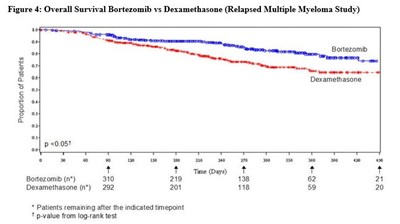
This is a comparison of overall survival between two drugs, Bortezomib and Dexamethasone, for patients with relapsed multiple myeloma. The data is presented in a table showing the number of patients remaining after certain time points for each drug. The table shows that at each timepoint, the number of patients remaining alive is higher for Bortezomib compared to Dexamethasone. The p-value from a log-rank test is also provided.*
Figure 5 - Figure 5
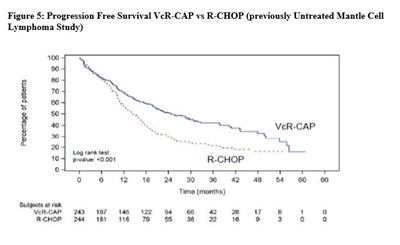
This is a figure presenting the Progression Free Survival of VeR-CAP vs R-CHOP in a study of previously untreated Mantle Cell Lymphoma. The graph shows the survival in months. There are no further details available in the text.*
Figure 6 - Figure 6
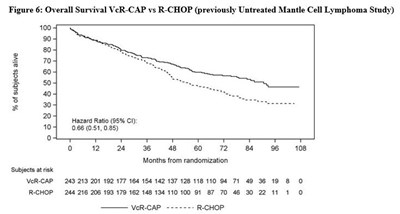
This is a comparison between the overall survival rates of VeR-CAP and R-CHOP treatments for previously untreated mantle cell lymphoma. The data is presented graphically, with months from randomization plotted against the percentage of subjects who are alive. The hazard ratio is noted to be 27% with a confidence interval of 35%. The VeR-CAP treatment group had higher overall survival rates than the R-CHOP group at all timepoints, with the difference becoming more pronounced over time.*
Instructions for Use - Instructions revised

This text provides information about the concentration and dosage of Bortezomib Injection. The first line indicates that there is a vial with a concentration of 1 mg/mL. The rest of the text provides a formula for calculating the appropriate dose based on patient body surface area and total injection volume. The second paragraph indicates that there is also a vial with a concentration of 2.5 mg/mL and provides the same formula for calculating dosage. This text may be useful for healthcare professionals administering Bortezomib Injection to patients.*
Table 10 - Table 10
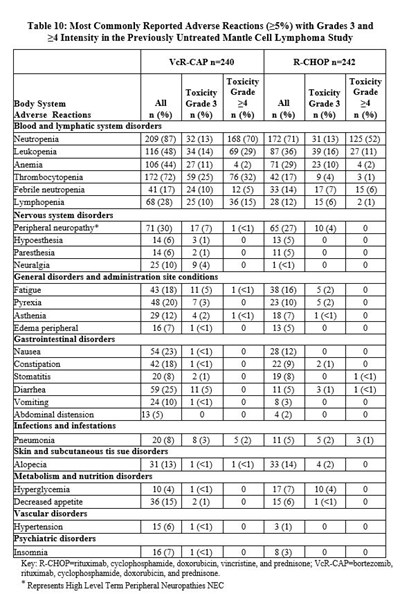
The table shows the most commonly reported adverse reactions with grades 3 and 4 intensity in a study of previously untreated mantle cell lymphoma. The study compared two treatments, VeR-CAP (bortezomib, rituximab, cyclophosphamide, doxorubicin, and prednisone) and R-CHOP (rituximab, cyclophosphamide, doxorubicin, vincristine, and prednisone). Adverse reactions are listed by body system and toxicity grade, including neutropenia, leukopenia, anemia, thrombocytopenia, and peripheral neuropathy.*
Table 11 - Table 11
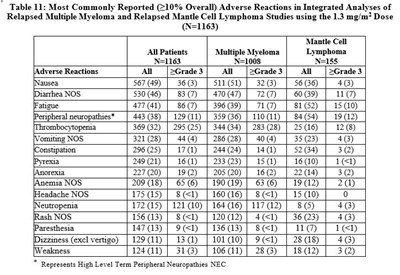
The table provides information on the most common adverse reactions in patients with relapsed multiple myeloma and relapsed mantle cell lymphoma who received a dosage of 1.3 mg/m². The data shows the frequency of occurrence of adverse reactions graded as 3 or higher. The table includes information on 19 adverse reactions such as nausea, diarrhea, fatigue, anemia, and paresthesia. Peripheral neuropathies were reported as the highest level term.*
Table 13 - Table 13
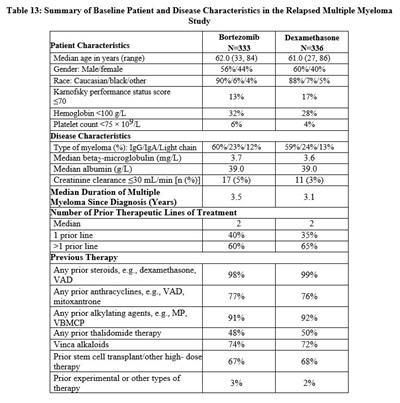
The table provides a summary of the baseline characteristics of patients with relapsed multiple myeloma involved in two studies that used Bortezomib or Dexamethasone. The information includes patient demographics such as age, gender, and race, as well as disease characteristics such as type of myeloma and previous therapies for the condition. Median duration of multiple myeloma since diagnosis and the number of prior therapeutic lines of treatment are also provided.*
Table 14 - Table 14
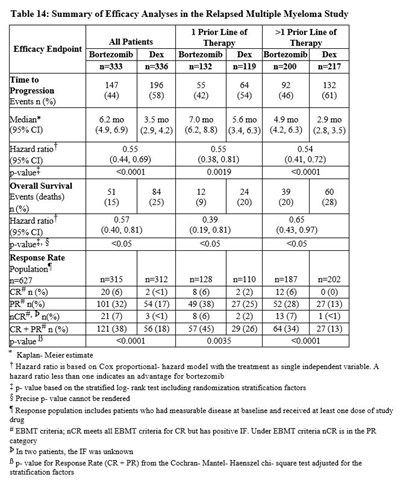
The text appears to be a table summarizing the efficacy analyses for a study on the treatment of relapsed multiple myeloma. The table includes information on patients who had received different prior lines of therapy and their corresponding efficacy endpoints, such as event occurrence, median overall survival, response rate, and hazard ratio. The table also includes statistical values and explanations of terminology used in the table.*
Table 15 - Table 15
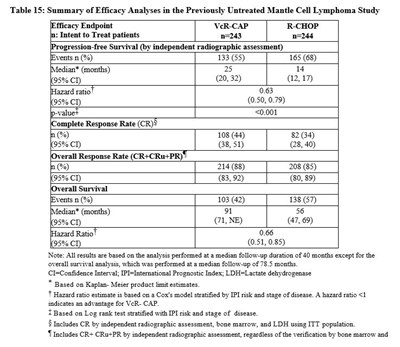
The text appears to be a table showing the efficacy analyses of a study on previously untreated mantle cell lymphoma using two treatments (VeR-CAP and R-CHOP) in terms of progression-free survival, complete response rate, overall response rate, and overall survival. The results are based on the analysis performed at a median follow-up duration of 40 months except for the overall survival analysis, which was performed at a median follow-up of 78.5 months. The Hazard ratio estimate is based on a Cox's mode stratified by TP risk and stage of disease.*
Table 16 - Table 16
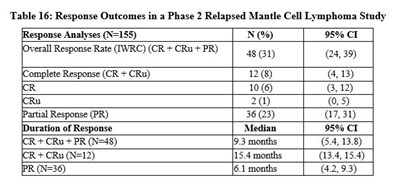
Table 16 shows the response outcomes in a Phase 2 study involving relapsed Mantle Cell Lymphoma, with a total of 155 response analyses. The table indicates the overall response rate, complete response, partial response, and duration of response. The complete response rate is 8%, with a CR + CRu of 12, and CR of 10. The CRu rate is 6%, and PR rate is 23%. The median duration of response for CR+ CRu-PR is 9.3 months.*
Table 7 - Table 7
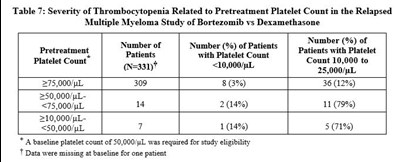
This is a table presenting the severity of Thrombocytopenia for a study comparing Bortezomib and Dexamethasone in relapsed Multiple Myeloma patients. The table displays the number and percentage of patients with different platelet counts (less than 10,000/μL, 50,000-75,000/μL, and 21,000-50,000/μL). The study required a minimum baseline platelet count of 30,000/μL, and data were missing for one patient.*
Table 8 - Table 8
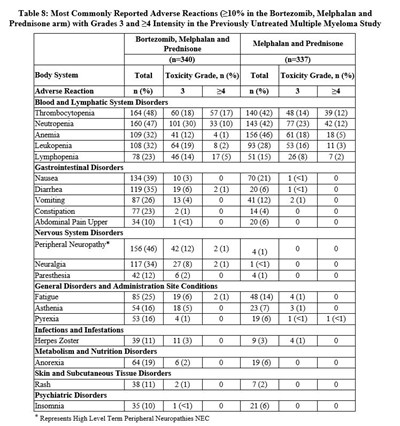
Table 8 shows the most commonly reported adverse reactions in the Bortezomib, Melphalan, and Prednisone treatment arm for previously untreated Multiple Myeloma patients. The table reports adverse reactions with more than 10% incidence and grades 3 and >4 intensity. Adverse reactions related to blood and lymphatic system disorders, gastrointestinal disorders, nervous system disorders, general disorders and administration site conditions, infections and infestations, metabolism and nutritional disorders, skin and subcutaneous tissue disorders, and psychiatric disorders are provided.*
Table 9 - Table 9
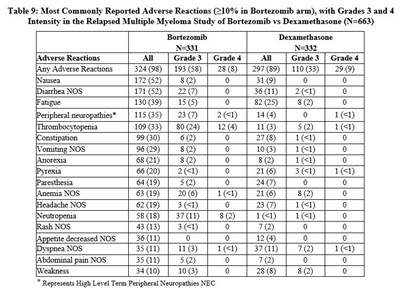
This is a table showing the most commonly reported adverse reactions for patients receiving bortezomib or dexamethasone in a study of relapsed multiple myeloma. The table includes the number of patients experiencing each adverse reaction, as well as the graded intensity of the reaction (with grades 3 and 4 noted). Adverse reactions with an incidence of more than 10% in the bortezomib arm are listed. The most common adverse reactions were nausea, diarrhea, fatigue, and peripheral neuropathies. Note that some of the data is truncated, and there is a notation regarding a high-level term for peripheral neuropathies.*
Label 1 mg - label revised 0008 1 mg
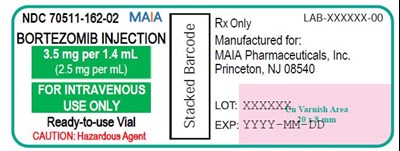
This is a description of a ready-to-use vial of Bortezomib Injection, manufactured by MAIA Pharmaceuticals, Inc. The NDC code for the product is 70511-162-02, and it contains 3.5mg per 1.4. It is important to note that this is a hazardous agent, and use should be conducted with caution. The lot number is visible, but the details are obscured, hence it reads as "LOT: XXXXX¥, Varnish Area". The expiry date of the product is available, and it reads "EXP: YYYY-MMIET™".*
Label 2.5 mg - label revised 0008 2 5mg

Bortezomib Injection is a hazardous agent for intravenous use only. Each 3.5mL vial contains 3.5mg of bortezomib, which is equivalent to 1mg/mL. The injection also contains other ingredients such as mannitol, sodium acetate, dimethyl sulfoxide, and Water for Injection. It must be stored refrigerated at 2° to 8°C (36 o 46°F) before use up to 7 days at 20° to 25°C (66° to 77°F). Its pH may have been adjusted using hydrochloric acid or sodium hydroxide. The recommended dosage is available in the prescribing information. Single doses are available, and the unused portions should be discarded properly. The manufacturer is MAIA Pharmaceuticals, Inc., located in Princeton, NJ.*
Table 12 - table 12

This is a table presenting results from an efficacy analysis of a study on previously untreated multiple myeloma. The study evaluates the effectiveness of bortezomib, melphalan, and prednisone compared to melphalan and prednisone alone. The table contains data on efficacy endpoints such as time to progression, progression-free survival, response rates, and overall survival. The results indicate that patients treated with bortezomib, melphalan, and prednisone had improved outcomes.*
Table 1 - table 1 revised

This is a table indicating the dosage and injection regimen for patients with previously untreated multiple myeloma using Bortezomib injection, Melphalan, and Prednisone. The table shows the dosages for twice weekly Bortezomib Injection for cycles 1 to 4 and once weekly Bortezomib Injection for cycles 5 to 9 when used in combination with Melphalan and Prednisone. The table displays the dosage and medication schedule for each week.*
Table 2 - table 2 revised
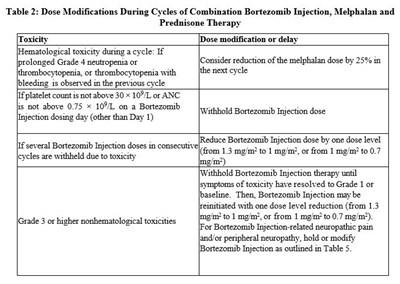
This is a table outlining the recommended dose modifications for the combination therapy of Bortezomib Injection, Melphalan, and Prednisone. The doses are modified based on observed toxicity levels and may involve reducing or withholding the Bortezomib Injection dose, reducing the melphalan dose by 25%, or modifying Bortezomib Injection therapy until symptoms of toxicity have resolved to Grade 1 or baseline. The table also provides guidance for cases of neuropathic pain and/or peripheral neuropathy related to Bortezomib Injection. The text appears to be in English and is easily readable.*
Table 3 - table 3 revised
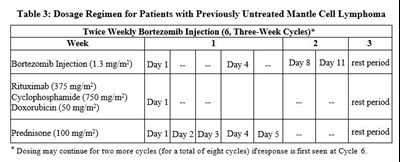
Table 3 shows the dosage regimen for patients with previously untreated Mantle Cell Lymphoma. The regimen involves twice-weekly Bortezomib injection for six three-week cycles, along with Rituximab, Cyclophosphamide, Doxorubicin, and Prednisone on specified days. The dosing may continue for two more cycles if a response is seen at Cycle 6.*
Table 4 - table 4 revised

This is a table outlining dose modifications and delays for a combination therapy including Bortezomib Injection, Rituximab, Cyclophosphamide, Doxorubicin and Prednisone. The modifications are based on the type and severity of hematological and non-hematological toxicities experienced by the patient. In some cases, Bortezomib Injection therapy should be withheld until the toxicity resolves or the patient's ANC and platelet count are at acceptable levels. The Bortezomib Injection dose should be reduced if toxicity resolves but modified for neuropathic pain and/or peripheral neuropathy.*
Table 5 - table 5 revised

This text provides a table that outlines recommended dose modifications for Bortezomib injections in patients who experience neuropathic pain and/or peripheral sensory or motor neuropathy. The table provides guidance based on the severity of the symptoms, ranging from no action required for Grade 1 asymptomatic patients to discontinuation of Bortezomib injection for those with Grade 4 life-threatening consequences. The grading system is based on the NCI Common Terminology Criteria CTCAE v4.0, and the table also explains the Instrumental Activities of Daily Living (ADL) and Self-care ADL terms.*
Table 6 - table 6 revised
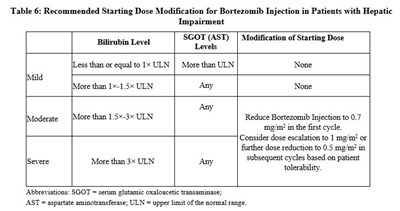
The text provides a table that recommends starting dose modifications for administering Bortezomib Injection to patients with different levels of hepatic impairment based on their SGOT (AST) levels. The table suggests either reducing the dose or considering dose escalation, depending on the severity of the impairment. The text also includes abbreviations for various medical terms.*
* The product label images have been analyzed using a combination of traditional computing and machine learning techniques. It should be noted that the descriptions provided may not be entirely accurate as they are experimental in nature. Use the information in this page at your own discretion and risk.


